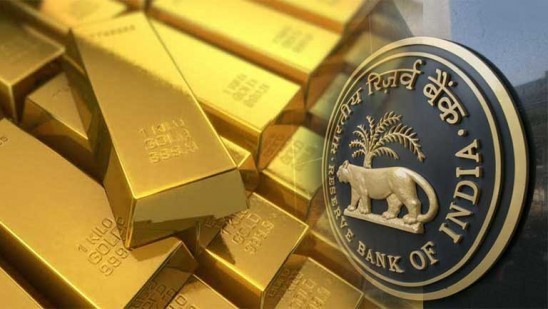Description

Disclaimer: Copyright infringement not intended.
Context
- The Reserve Bank of India’s (RBI) gold reserves touched 794.64 metric tonnes in fiscal 2023, an increase of nearly 5 per cent over fiscal 2022, when it held 760.42 metric tonnes of gold.
Trends of RBI’s Gold Reserves
- The RBI has been building up its gold reserves for the last five-six years.
- RBI held 760.42 metric tonnes as of March 31, 2022, compared to 695.31 metric tonnes as of March 31, 2021.
- The gold reserves as of March 31, 2023, included gold deposits of 56.32 metric tonnes, according to the RBI’s half-yearly report on Management of Foreign Exchange Reserves- October 2022 – March 2023.
- While 22 metric tonnes of gold is held overseas in safe custody with the Bank of England and the Bank of International Settlements (BIS), 301.10 metric tonnes of gold is held domestically.
- As of March 31, 2023, the country’s total foreign exchange reserves stood at $578.449 billion, and gold reserves were at $45.2 billion.
- In value terms (USD), the share of gold in the total foreign exchange reserves increased from about 7 per cent at end-March 2022 to about 7.81 per cent as at end-March 2023.
- The share of gold reserves to the country’s total forex reserves stood at 7.06 per cent as of end-September 2022.
- A recent World Gold Council (WGC) report showed that the RBI added 7 metric tonnes of gold in January-March 2023.

So why are these reserves increasing?
- Because, as part of the diversification process, the RBI has been adding gold to its reserves, which is considered a more safe, secure, and liquid asset, to safeguard its returns amid global uncertainty and a rising inflation scenario.
- RBI has been stepping up its gold purchases over the last few years in order to diversify its overall reserves.
- This change in strategy, according to experts, has been driven by negative interest rates in the past, the weakening of the dollar, and growing geopolitical uncertainty.
- Central banks want security, safety, liquidity and return. Gold is a safe asset to have as it is liquid, has an international price which is transparent, and as it can be traded anytime. So, central banks are buying gold.
Which other Banks are buying Gold?
- Many other central banks, including the Monetary Authority of Singapore (MAS), the People’s Bank of China (PBoC) and the Central Bank of the Republic of Turkey have been buying gold.
- In the calendar year 2022, central banks around the world purchased 1,136 tonnes of gold, which was a record high.
- The two key drivers of central banks’ decisions to hold gold are its performance during times of crisis, and its role as a long-term store of value.
- In a year scarred by geopolitical uncertainty and rampant inflation, central banks opted to continue adding gold to their coffers and at an accelerated pace.
FOREX RESERVES: https://www.iasgyan.in/daily-current-affairs/forex-reserves-35
Gold is a good hedge
- Gold is a good hedge during times of uncertainty and economic turmoil, so every major central bank keeps some of its reserves in gold.
- Gold prices rise when the economy is in flux, as was the case in 2020 when the economic turmoil caused by Covid reached an all-time high of $2,067 per ounce.
- With economic stability, demand for yellow metal decreased, and prices consistently fell in 2021. The massive purchase of gold by the RBI in 2021 took place against the backdrop of a falling price for yellow metal on the global bullion market.
- However, the War in Europe proved beneficial to gold, as the price of an ounce of gold crossed $2,000 in the first week of March 2022. Though gold lost some of its gains in the middle of March as bonds emerged as appealing investment options for institutional investors and retail investors and the Dollar Index was strengthened by the Federal Reserve's consistent rate hikes.
Role of gold in the economy
- For most of the 20th century, gold served as the world's reserve currency.
- The United States used the gold standard until 1971. They were required to have equivalent reserves of gold to back up the paper money. Due to the volatility of the US dollar and other currencies, some economists believe that we should return to the gold standard even though it has been discontinued.
- Due to its inherent value and limited supply, inflationary periods see an increase in demand for gold. The yellow metal is able to keep its value much longer than other forms of currency because it cannot be diluted.
- The value of a nation's currency will decrease when that nation imports more than it exports. A country that is a net exporter, on the other hand, will see an increase in the value of its currency.
- As this raises the value of the country's total exports, a nation that exports gold or has access to gold reserves will see an increase in the strength of its currency when gold prices rise.
- Since the central banks depend on printing more cash to purchase gold, they create an excess supply of the currency. This increases the supply and thereby reduces the value of the currency used to buy it.
|
PRACTICE QUESTION
Q) The RBI has been building up its gold reserves for the last five-six years. Give reasons. What is the role of Gold in an Economy?
|

https://indianexpress.com/article/business/banking-and-finance/reserve-banks-gold-reserves-rose-4-5-to-794-64-tonnes-in-2022-23-8598814/













